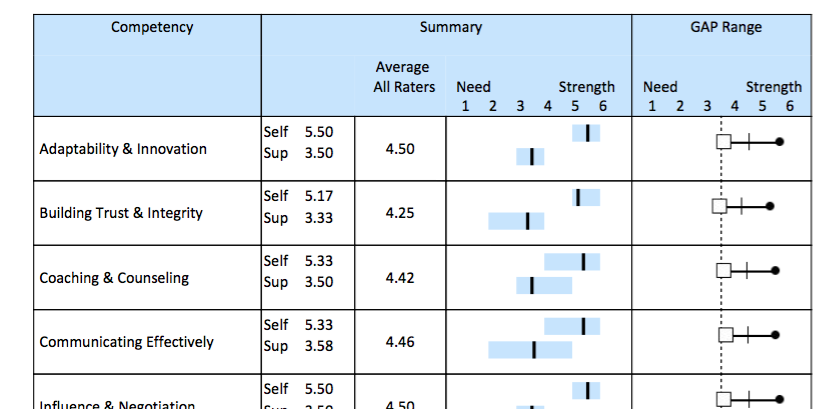
In any industry, it’s easy to get off track, even with a well-honed strategic plan in place. It’s common for employees of a business or organization to work diligently, with their heads down for an extended period of time, only to look up and wonder – “Where are we?” – surprised that their surroundings look nothing like what they were expecting. In another scenario, a “working conditions survey” is conducted and management discovers that the company isn’t doing as well as it believed it was doing.
This is when it’s time to consider a gap analysis report. Conducting periodic gap analyses is absolutely necessary for the long-term success and longevity of an organization.
What is a Gap Analysis?
Gap analysis is a means by which an organization, company or firm compares its actual performance to its expected, desired or potential performance. An analysis is conducted to see whether the company is meeting expectations in various arenas, such as productivity, employee relations, worker engagement/satisfaction and profit margin. It’s also used to determine whether resources are being strategically invested and used effectively. In truth, gap analysis is one of the most basic components of any organization’s success.
When & Why Should Organizations Run Gap Analysis Reports?
Gap analysis reports are helpful for a range of situations. Such a study can be conducted before a project ever begins or it can be used to get a company back on track. Here are some scenarios:
Underperformance
It’s easy for an organization to perform or produce below its potential or expected target. It happens more often than not. Thus, if leadership suspects that potential targets aren’t being reached, it may be time for a gap analysis report.
New Projects
When embarking on a new project, whether it’s merely a small company change or a large vision to birth a new organization, you will need to outline the steps of how to get from where you are (actual) to where you want to be (desired or potential). A well-crafted gap analysis report can explain your vision in a clear and concise way in order to be presented to senior-level management, bank or investors for approval.
Developing Employees
A gap analysis is useful for growing people to improve their performance. Such a practice is often used in corporate settings when workers are placed on action plans to improve areas of weakness. Gap analyses are also conducted to ensure that employees and their supervisors are on the same page–sharing a similar perception of how well things are going–which areas are going great and which areas could use improvement. This could include the employee’s ability to adapt, to communicate effectively, to manage conflict, or any of the other core competencies.
As pointed out in the HR Logistics book, Measuring Talent Management By Building The Employee Gap Analysis, “every candidate (or employee) should have a skills gap…the goal is to find it and manage the risk of its impact on the organization.”
Could Your Employee Relations (And Performance) Be Better?
In March 2016, Gallup reported that 34.1% of U.S. employees were engaged by their work that month. It was the highest worker engagement statistic since Gallup started tracking engagement in 2011. This points to a dismal fact: Worker engagement has trended between 28-34% since 2011. Thus 72-66% of U.S. workers have NOT been engaged with their work. Disengaged, dissatisfied workers are a symptom of poor employee relations. Employee relations is simply not working.
This is the reality. The pertinent question is: Does a company want to turn this statistic around, particularly before the bottom line is affected? Research shows that disenchanted workers are disloyal, unproductive and negatively affect the bottom line.
Improve Employee Relations Gap Analysis Reports
What can you do if your company is experiencing low employee engagement? By applying gap analysis methodology to the factors that affect worker engagement, you can examine the actions and behaviors that affect the engagement and satisfaction of your employees. You must establish measurable, tangible variables that can be formed into workable targets.
This is where third-party companies, like Edge Training, come in: Edge Training offers gap analysis options that have been proven to get insightful, accurate, and actionable results. Once your employees and you, or your managers, have completed the analyses, you’ll be ready to take the necessary steps for developing those working relationships and improving employee (and manager) performance. Here’s an example of what a gap analysis would look like from Edge Training…
Example of Gap Analysis for Improving Employee Relations (click to see the full sample report):

Every organization’s leadership can utilize gap analysis methodology, whether it’s to start a new venture or to make much-needed change. It’s an effective way to evaluate the present state of your company and ensure that all people involved are on the same page and are working toward a common goal. Used properly and periodically, gap analysis will improve your organization’s employee relations and productivity and ensure its long-term success.
You may also be interested in these employee development posts:
- Learn How To Identify & Develop High Potential Employees
- 10 Tips For Developing Employees You Can Trust
- Retaining Millennial Employees Through Leadership Development
To learn more about the benefits of gap analyses and how they can improve employee relations and performance, contact Edge Training at 800-305-2025.

